Contents
Rose
The rose plant (genus Rosa) is a woody perennial flowering shrub famed worldwide for its beautiful, often fragrant blooms. Roses are among the most popular types of flowers in cultivation, admired in gardens, bouquets, and landscapes across the globe. Sometimes called the “Queen of Flowers,” the rose has a rich history dating back thousands of years. Its blossoms come in a wide range of colors classic red, elegant white, soft pink, sunny yellow, and more with red roses particularly symbolic of love and beauty. There are thousands of cultivated varieties (cultivars) of roses, bred for their flower form, color, and scent. As one of the iconic red flowers, the rose shares gardens with other beloved blooms like carnations and tulips, yet it stands apart for its cultural significance and romantic reputation. Beyond ornamentation, roses have practical uses too: rose oil and rose water distilled from the petals are valued in perfumery and cuisine, and rose hips (the fruit) are rich in vitamin C. The importance of the rose is even officially recognized, it was designated the national floral emblem of the United States in 1986. Overall, the rose plant’s enduring appeal lies in its combination of beauty, fragrance, and versatility, making it a cornerstone of horticulture and flower gardening.
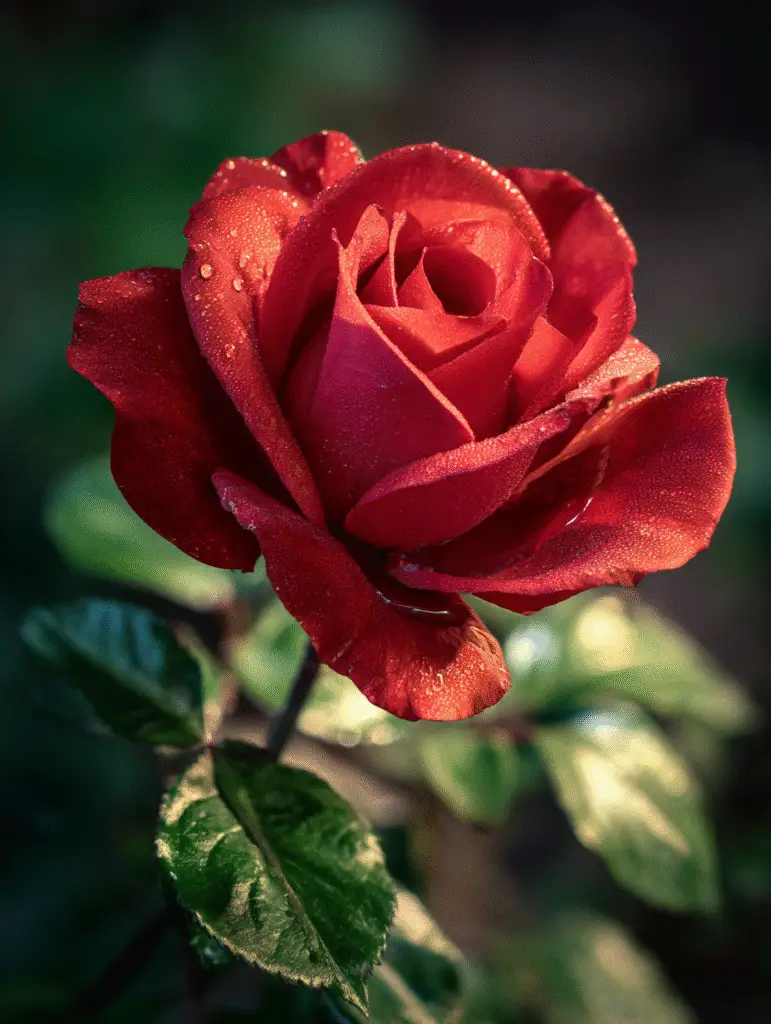
🌱 Taxonomy and origin
Botanically, the rose belongs to the genus Rosa in the rose family, Rosaceae. There are well over 100 wild Rosa species identified (some sources cite up to 150 or more), consisting of deciduous shrubs, climbing vines, and trailing groundcovers. These species are native primarily to temperate regions of the Northern Hemisphere. The greatest diversity of wild roses is found in Asia, while others are indigenous to Europe, North America, and parts of North Africa. In the wild, roses typically have simple flowers with five petals and bear berry-like fruit called rose hips.
Roses have an ancient history of cultivation and domestication. Humans have grown and admired rose plants for thousands of years. Historical evidence shows that roses were cultivated in China as early as 5,000 years ago, and they held importance in ancient Babylonian, Egyptian, Greek, and Roman gardens. By the Classical era, varieties of roses were being traded and grown across the Middle East and Europe for their beauty and fragrance. Many of today’s garden roses descend from hybridization between European and East Asian species. In the 18th and 19th centuries, Chinese repeat-blooming roses were introduced to Europe, revolutionizing rose breeding by imparting the ability to flower multiple times per season. This led to the development of modern hybrids like the hybrid tea, floribunda, and grandiflora classes. Over time, countless cultivars have been bred worldwide, making the rose a truly global ornamental plant with a rich botanical heritage.
🌸 Bloom time
Roses generally bloom in the warmer months, but the exact timing and frequency depend on the type of rose. Most modern roses (including hybrid teas, floribundas, and many shrub roses) are repeat-blooming, producing flushes of flowers from late spring through summer and into fall. These varieties often have a major bloom in late spring or early summer, followed by additional smaller bloom cycles every 4 to 8 weeks, especially if spent blooms are removed (deadheaded). In contrast, some old-fashioned and wild roses are once-blooming they flower just once per year, usually in late spring to early summer, then form hips and do not rebloom until the next season. Climate also plays a role in bloom time. In colder regions, roses typically start blooming in May or June, whereas in mild or subtropical climates (USDA Zones 9–11), some roses can start earlier and even continue flowering year-round with only brief rest periods. Overall, with proper care and conditions, many garden roses offer a long bloom season, providing color and fragrance throughout the growing season.
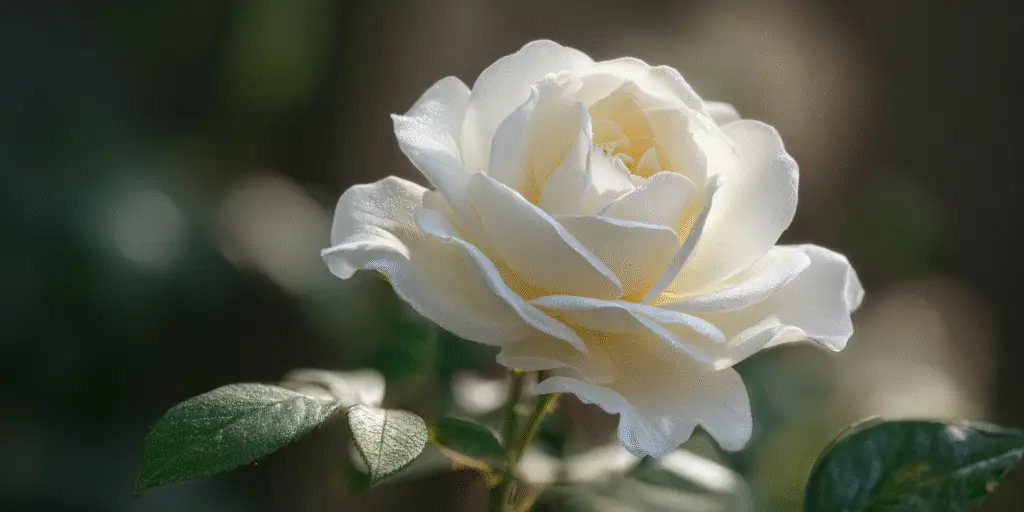
📏 Height and spread
The size of a rose plant can vary greatly depending on the variety and growth habit. On the small end, miniature and patio roses may grow only about 1 to 2 feet tall, forming compact little bushes ideal for containers or borders. Most traditional garden rose bushes (such as hybrid teas and floribundas) reach in the range of 3 to 6 feet tall and typically 2 to 4 feet wide, developing a rounded shrub form. There are also larger shrub roses and old garden roses that can grow 6 to 8 feet high with an equal spread if left unpruned. At the other extreme, climbing and rambling roses produce long canes that, when trained on trellises or arbors, can easily attain heights of 10 to 15 feet or more, spreading extensively along supports or fences. These vigorous climbers can cover a large area, though they require structural support since they don’t cling like vines on their own. In general, whatever the ultimate size, most rose plants can be managed by pruning to maintain the desired height and shape in the garden.
☀️ Light
Roses perform best with ample sunlight. Most rose varieties prefer full sun, which means at least 6 hours of direct sunlight per day. A sunny location encourages robust growth, abundant flowering, and helps keep fungal diseases at bay by drying the foliage. In too much shade, rose plants tend to become leggy (stretching toward light) and produce fewer blooms, they may also be more prone to problems like mildew due to slower drying of leaves. In cooler or temperate climates, giving roses all-day sun is ideal. In very hot regions (such as areas with intense afternoon sun or in the Deep South), roses still need plenty of sun but can benefit from some light afternoon shade to prevent scorching of the flowers and foliage during the peak of summer. Overall, a location with morning and early afternoon sun exposure and good airflow is optimal for healthy, floriferous rose bushes.
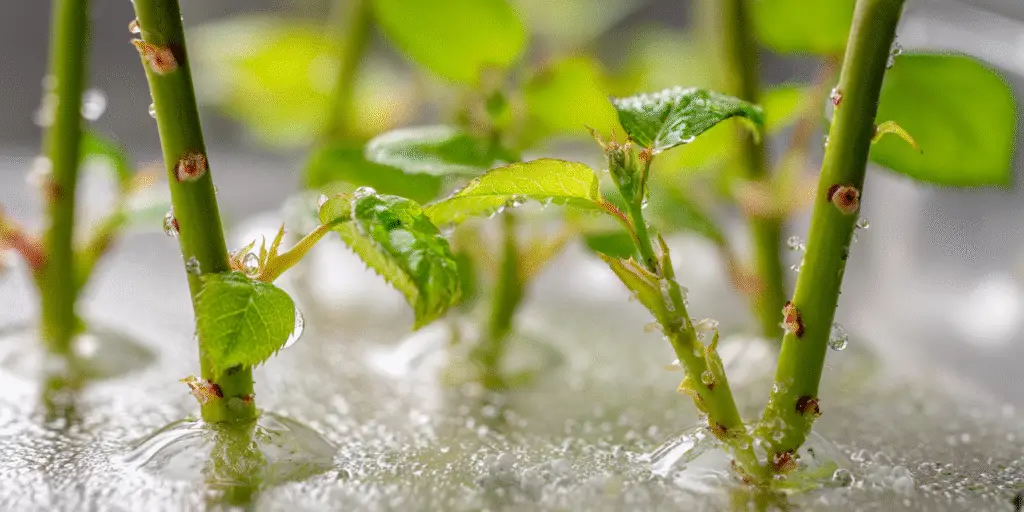
💧 Water
Consistent moisture is important for roses to thrive and bloom well. Roses generally need regular watering, about 1 inch of water per week on average, though the exact amount can vary with climate and soil conditions. In hot summer weather or dry climates, roses will likely need more frequent watering (perhaps every 2–3 days) to prevent the soil from drying out completely. It’s best to water deeply and at the base of the plant, ensuring the root zone gets soaked, deep watering encourages roses to develop extensive roots that can support abundant flowers. Avoid getting the foliage wet if possible (for example, use a soaker hose or drip irrigation) because wet leaves, especially overnight, can promote fungal diseases like black spot. Morning is the ideal time to water, allowing any splashes on leaves to dry quickly in the sun. While roses appreciate moisture, they do not like to sit in waterlogged soil good drainage is key to prevent root rot. Striking a balance is important: keep the soil consistently moist but not soggy. A layer of mulch around the base of the rose can help retain soil moisture and reduce the frequency of watering needed, especially during summer.
🌍 Soil and pH
Roses grow best in fertile, well-draining soil. A rich loam that has plenty of organic matter (such as compost or well-rotted manure) provides the ideal environment for rose roots. Good drainage is essential because roses do not tolerate waterlogged or boggy soil soggy conditions can lead to root diseases. If the native soil is heavy clay, it helps to improve it by working in organic matter to loosen the texture, or planting roses in raised beds to ensure water does not accumulate around the roots. In sandy soil, adding compost can help retain moisture and nutrients for the rose. Regarding soil pH, roses prefer a slightly acidic to neutral soil. An optimal pH range is about 6.0 to 6.8, with around 6.5 often cited as ideal for nutrient availability. They can generally tolerate pH in the range of roughly 6 to 7.5, but if the soil is extremely acidic or alkaline, the plant may struggle to absorb nutrients. It’s a good practice to test the soil pH and adjust it if needed (for example, adding lime to raise pH or sulfur to lower pH) to keep it in a comfortable range for roses. In summary, a loose, nutrient-rich soil that drains well and has a slightly acidic pH will give the best results for rose cultivation.
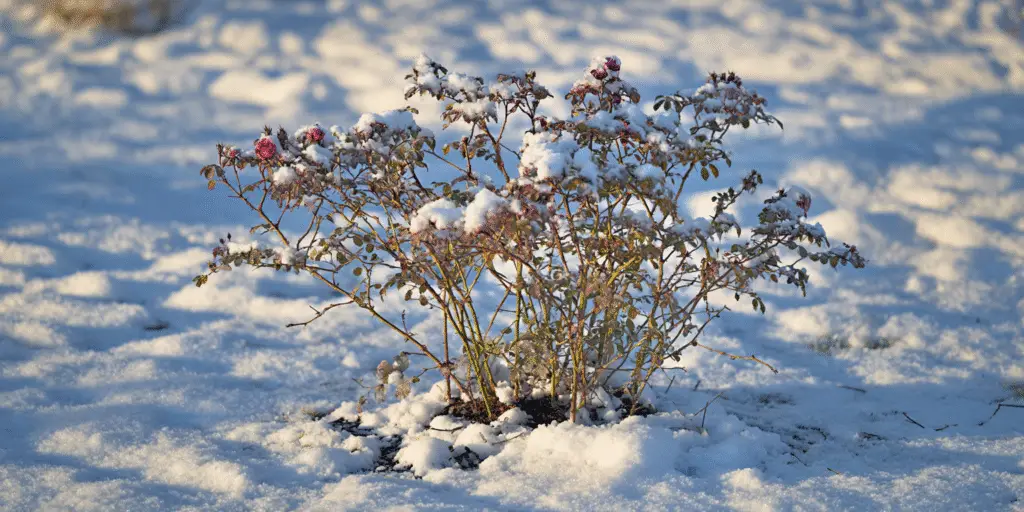
❄️ USDA hardiness
The cold-hardiness of rose plants varies widely, but many garden roses are adapted to a broad range of climates. In general, most popular rose cultivars thrive in USDA Hardiness Zones 5 through 9. This covers the majority of the continental United States, from relatively cool to warm temperate regions. Some roses are extremely cold-hardy: certain species and specially bred shrub roses (including many old garden roses and Canadian-bred varieties) can survive winters in Zones 3 and 4, provided they have some protection such as heavy mulch or snow cover. For example, Rugosa roses and other hardy types are known to tolerate sub-zero temperatures. On the other end of the spectrum, there are roses that prefer milder winter climates. Tender varieties, including some hybrid tea or tropical-origin roses, may only prosper in Zones 8 to 11, where freezing is minimal, these may suffer or need extra care (like winterizing or moving to a greenhouse) in colder zones. In very hot regions (Zone 10 and above), roses can grow year-round, but they might experience heat stress in extreme summer conditions and benefit from some afternoon shade and extra water. Many modern roses are grafted onto robust rootstocks to improve their vigor and climate adaptability. Nonetheless, it’s important for gardeners to check the recommended zone range for specific rose varieties and provide winter protection (such as mulching the base or burlap wrapping) for those at the colder end of their range. With proper selection and care, there are roses suitable for virtually every zone from chilly northern gardens to subtropical climates.
🌼 Propagation and longevity
Roses can be propagated in several ways, though some methods are easier for home gardeners than others. One common method is rooting stem cuttings. Many rose varieties can be propagated from cuttings of young stems: a cutting of about 6 inches with a few leaves is taken and placed in a moist rooting medium until it develops roots. Success rates vary by variety (some root easily, others are stubborn), but this is a straightforward way to clone a rose bush. Another propagation technique is layering, where a low cane is bent to the ground and partially buried until it forms its own roots (after which it can be cut from the mother plant). However, the most widespread method used by nurseries is grafting or budding. In grafting, a desired rose cultivar (scion) is budded onto a hardy rootstock, the rootstock provides vigor and disease resistance, while the top part produces the chosen flowers. Nearly all hybrid tea roses and many others from commercial sources are grafted onto rootstocks like Dr. Huey or multiflora rose. Growing roses from seeds is also possible, especially for breeding new varieties or for certain species roses, but seed-grown roses will not be identical to the parent if it’s a hybrid (and seeds can take a long time to germinate after stratification). Therefore, for gardeners, propagation is typically done by cuttings or by purchasing grafted plants rather than starting from seed.
Roses are perennial plants (unlike annual blooms such as poppies) and can live a long time with proper care. The lifespan of a rose bush often depends on its type and care regimen. Many modern hybrid roses will live and bloom vigorously for around 10 to 15 years on average, and with excellent care (regular pruning, feeding, and disease management) they can certainly last longer. Some hardy old garden roses and climbing roses are known to survive for several decades. It’s not uncommon to find heirloom roses in old gardens that are 50 years old or more and still healthy. In fact, one of the oldest known roses is the legendary “Thousand-year Rose” growing on a wall of Hildesheim Cathedral in Germany believed to be over 700–1,000 years old and still blooming. While most garden roses won’t reach anywhere near that age, these examples show that under ideal conditions a rose plant’s longevity can be impressive. Generally, if a rose bush starts declining after many years, gardeners may rejuvenate it by heavy pruning or choose to replace it. But overall, investing in good care can keep a rose growing and flowering beautifully for a very long time.
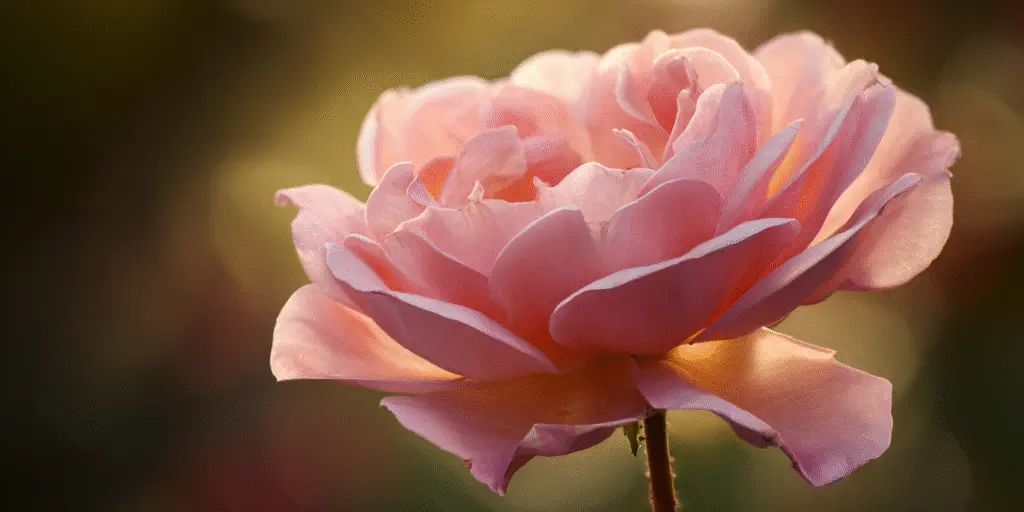
👃 Fragrance
One of the greatest delights of roses is their fragrance. Many roses are well-known for carrying a sweet, rich scent in their blossoms, although fragrance can vary widely among different varieties. Traditional old garden roses, such as damask and Bourbon roses, are often extremely fragrant, exuding the classic “rose perfume” that has been cherished for centuries. Modern hybrid roses range from intensely scented to nearly scentless, some hybrid tea roses have a strong fragrance, while others were bred more for bloom form or color at the expense of scent. In general, pink and red roses tend to have the strongest typical rose smell, while some yellow and orange varieties might have a spicier or more fruity scent, and white roses sometimes offer a tea-like or musk fragrance. The time of day can influence how strongly a rose smells often the aroma is most pronounced in the early morning or on warm, humid days. If fragrance is a priority, gardeners should select cultivars specifically noted for it (catalogs and labels often indicate fragrance level). Beyond enjoyment in the garden, rose fragrance has practical uses: certain roses (notably the damask rose, Rosa damascena, and the cabbage rose, Rosa centifolia) are grown commercially for their highly fragrant petals, which are distilled into rose oil (attar of roses) used in perfumes, cosmetics, and aromatherapy. Even a few petals floated in a bowl of water can lightly scent a room. While not every rose is powerfully perfumed, the best ones provide an unforgettable sensory experience with their blooms.
⚠️ Toxicity and pet safety
Garden roses are generally considered non-toxic, which is good news for households with pets or children. Unlike some ornamental plants, roses do not contain inherent poisons in their flowers, leaves, or stems. According to the ASPCA, Rosa species are non-toxic to dogs, cats, and horses. This means if a curious pet happens to nibble a rose petal or leaf, it shouldn’t cause poisoning (though eating any plant material might lead to minor stomach upset). In fact, humans have long used certain rose petals in cooking (for example, in desserts or teas) and rose hips are consumed for their high vitamin C content. The primary safety concern with roses isn’t chemicals in the plant, but rather physical hazards: the sharp thorns. Rose thorns can prick or scratch the skin, potentially leading to small wounds. Gardeners should take care when handling rose bushes, wearing gloves and long sleeves to avoid scratches. If a thorn does puncture the skin, it’s wise to clean the area to prevent any infection (in rare cases, a fungus on rose thorns can cause a condition nicknamed “rose gardener’s disease”). Additionally, if roses have been sprayed with pesticides or systemic insecticides, those chemicals could pose a risk if ingested by pets or people, so it’s important to use pet-safe products and keep curious animals away from freshly treated plants. Overall, the rose plant itself is safe to grow around pets and family, as long as one respects the thorns.
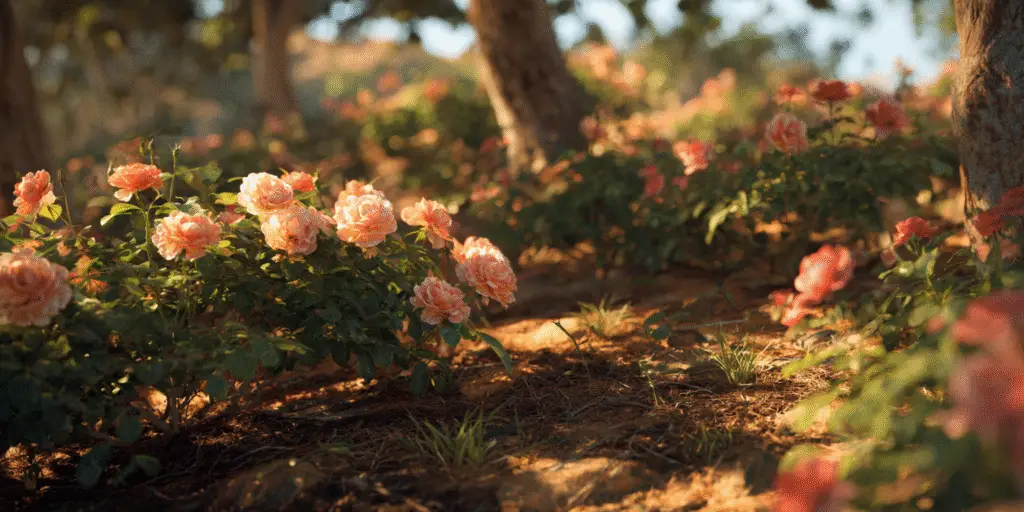
🌿 Vase life
Roses are one of the most popular cut flowers for arrangements, known for their elegance in vases and bouquets. Once cut, a fresh rose typically lasts about a week in the vase under good conditions. Many roses will maintain attractive blooms for roughly 5 to 7 days, some varieties, especially those bred for the floral trade, can last 7 to 10 days or occasionally up to two weeks with excellent care. To maximize the vase life of cut roses, a few tips are recommended: cut the stems at an angle (and re-cut them every couple of days) to help them take up water, place them in a clean vase with fresh water, and use a floral preservative or plant food in the water if available. Keeping the arrangement in a cool spot out of direct sunlight and away from heat sources or drafts also helps the roses stay fresh longer. Removing any leaves that would sit below the water line will prevent bacterial growth that can shorten vase life. Despite all care, some delicate garden rose varieties may have shorter vase lives (only a few days) compared to the long-lasting roses sold by florists, which are chosen for their durability. In summary, expect about a week of beauty from cut roses on average, and follow good floral care practices to enjoy them at their best for as long as possible.
🐛 Pests and diseases
Like many beloved garden plants, roses can face a number of pest and disease challenges. Among insect pests, aphids are notorious on roses they often cluster on new growth and buds, sucking sap and causing distorted leaves or buds. These tiny insects can multiply quickly and also afflict other garden favorites like hibiscus and geraniums. Spraying them off with water or using insecticidal soap can help manage aphids. Another common pest is the Japanese beetle (in regions where it is present), these metallic green beetles chew on rose foliage and flower petals, sometimes skeletonizing leaves and ruining blooms. Handpicking or trapping can reduce Japanese beetle damage. Spider mites can be an issue in hot, dry weather, causing a fine speckling or bronzing on leaves, keeping roses well-watered and occasionally hosing off the undersides of leaves can deter mites. Thrips are tiny insects that can infest rose blooms, leading to browning or deformed petals, especially in light-colored roses. Sawfly larvae, often called rose slugs, chew semi-transparent “windows” into leaves or eat the leaves down to a lacy skeleton, these can be controlled by hand-picking the larvae or using appropriate insecticides if infestations are severe. Additionally, larger critters can be “pests” – for example, deer are known to browse on rose buds and can strip a bush overnight, and rabbits might nibble young stems. Protective fencing or repellents may be needed in areas with heavy wildlife pressure.
Roses are also prone to several diseases, mostly fungal, especially in humid or wet conditions. Black spot is perhaps the most infamous rose disease: it’s a fungus (Diplocarpon rosae) that creates black, rounded spots with yellow halos on leaves, eventually causing the foliage to yellow and drop off. Regular cleanup of fallen leaves and planting disease-resistant cultivars are key preventive measures, as is applying fungicidal sprays when necessary. Powdery mildew is another common fungus despite its name, it often appears in dry conditions with cool nights, coating rose leaves and buds in a white powdery film. Good airflow around plants and fungicides can manage powdery mildew. Rust is a fungus that produces orange, powdery spots (pustules) on the undersides of leaves, it can cause defoliation in severe cases and is managed similarly with sanitation and sprays. Another threat is downy mildew, which causes purplish-red blotches on leaves and can quickly defoliate a plant in cool, wet weather this disease often strikes suddenly and may require aggressive treatment. Botrytis blight (gray mold) can affect rose blooms in prolonged wet or humid weather, turning petals brown and covering them with fuzzy gray mold. Aside from fungi, roses can suffer from viral diseases too. The most notable is Rose Rosette Disease (RRD), caused by a virus spread by tiny eriophyid mites, it leads to abnormally reddened, witch’s broom-like growth and ultimately kills the plant. Unfortunately, there is no cure for RRD, and affected plants must be removed to prevent spread. Overall, maintaining rose health through proper cultural practices such as planting in sunny, airy locations, watering at the base, spacing plants for airflow, and pruning to remove diseased material will minimize pest and disease issues. Many modern roses are bred for improved disease resistance, which can significantly reduce problems and maintenance. With attentive care, gardeners can keep rose problems in check and enjoy healthy plants.
FAQs
Are roses annuals or perennials?
Roses are perennials. A rose bush will live for many years (often decades) if maintained, going dormant in winter and re-sprouting each spring. They are not annuals, they do not die after one season, although in very cold climates the tops may die back and regrow from the base in spring.
Do roses need full sun, or can they grow in shade?
Roses do best in full sun. Ideally they should get at least 6 hours of direct sunlight per day to bloom profusely. While some roses can tolerate partial shade (especially in very hot climates where a bit of afternoon shade is beneficial), too much shade will result in fewer flowers and more disease issues. For the healthiest rose bushes and best flowering, plant them in a sunny spot.
How often should I water my rose bush?
Water roses deeply whenever the top inch or two of soil dries out. Typically, this means about once or twice a week with a thorough soaking, depending on weather and soil. In hot, dry conditions you may need to water more frequently. It’s better to water deeply less often than to sprinkle lightly every day. Always try to water at the base of the plant to keep leaves dry.
When is the best time to prune a rose bush?
The best time for a major prune on most roses is in late winter or very early spring, just as the plants are coming out of dormancy (often around late February or March in many areas). At that time, you can cut back the canes to shape the plant and remove any dead or weak wood. For once-blooming roses that only flower in spring, wait until right after they finish blooming to prune, since they bloom on old wood. Throughout the growing season, you can also do light pruning or deadheading to remove spent blooms and tidy up the plant as needed.
Can I grow roses in containers or pots?
Yes, you can grow roses in containers as long as the pot is large enough. Choose a deep pot (at least 14–18 inches in diameter for most roses, larger for big varieties) with good drainage holes. Use a high-quality potting mix, and water potted roses more frequently since containers dry out faster. Fertilize regularly as nutrients leach out from pots with watering. Many people grow miniature roses or compact shrub roses very successfully on patios and balconies. Just remember that container roses may need extra protection in winter, as their roots are more exposed to cold.
Why isn’t my rose bush blooming?
If your rose isn’t blooming, a few factors could be at play. Lack of sufficient sunlight is a common reason roses need plenty of sun to produce flowers. Also, if you pruned at the wrong time (for example, cutting back a once-blooming rose in spring), you might have removed the wood that would have produced blooms. Nutrient issues could be a cause too: roses that are underfed or lacking phosphorus may bloom poorly. Severe pest or disease problems, or stress from drought, can also inhibit blooming. Ensure your rose is getting enough light, water, and nutrients, and prune it correctly for its type. With the right care, it should resume blooming.
Are roses safe for pets (cats and dogs)?
Yes. Roses themselves are considered non-toxic to cats and dogs. If a pet bites or eats a rose petal or leaf, it generally won’t be harmed (aside from possible mild stomach upset). Do be cautious of thorns, though, as these can cause injuries to curious pets. Also, avoid using any pesticides on your roses that could be harmful if your pet chews on the leaves.
How long does a rose plant live?
A healthy rose plant can live for many years, often multiple decades. Many modern rose bushes will thrive for 10–15 years or more with good care. Some hardy heirloom roses have been known to live 50 years or longer. Over time a rose might start to decline in vigor or flower production, at which point gardeners may choose to rejuvenate it with pruning or replace it. But roses are long-lived perennials unlike annual flowers, they don’t die each year after blooming.
Can I grow roses from cuttings or seeds?
You can propagate roses from cuttings, and many gardeners do this to clone a favorite rose. To root a cutting, take a 6–8-inch piece of a healthy stem, plant it in a moist rooting medium, and keep it humid until roots form (this can take several weeks). Success is not guaranteed with every attempt, but it’s an inexpensive way to get new rose plants. Growing roses from seeds is less common for home gardeners, because seeds from hybrid roses won’t produce the same plant as the parent (offspring can vary). Also, rose seeds need a period of cold stratification and can take a long time to sprout, and then years to mature and bloom. Plant propagation from seed is mainly done by rose breeders developing new varieties, whereas rooting cuttings or buying grafted roses are the preferred methods to propagate existing varieties.
Interesting tips
- Choose the right variety: Pick rose varieties suited to your climate and garden conditions. For cold climates, select hardy or own-root roses that can survive winter, and look for disease-resistant cultivars if black spot is a problem in your area.
- Plant in a sunny, well-drained spot: Roses do best with plenty of sun and good soil. Choose a site that gets at least 6 hours of sun daily and prepare the planting hole with compost to enrich the soil. Ensure the area has good drainage so the roots don’t sit in water.
- Water deeply and mulch: Give roses a thorough soaking at the base once or twice a week rather than light frequent sprinklings. Deep watering encourages strong roots. Apply a layer of organic mulch (like wood chips or straw) around the base of the plant to conserve moisture, suppress weeds, and keep the roots cool.
- Feed during the growing season: Roses are heavy feeders. Use a balanced rose fertilizer or compost to feed your plants, especially in spring as they start growing and again in mid-summer. Regular feeding promotes more blooms and healthy growth, but stop fertilizing by late summer to allow the plant to harden off before winter.
- Prune properly each year: Annual pruning keeps roses healthy and productive. In late winter or early spring (when the plant is still dormant or just starting to bud out), prune out dead or diseased wood and shape the plant by cutting back canes. Remove any weak, crossing, or inward-growing stems to improve airflow. Always use clean, sharp pruning tools, and make cuts just above outward-facing buds.
- Deadhead spent blooms: After a rose flower fades, snip it off (deadhead) to encourage the plant to produce new blooms. Removing spent flowers prevents the plant from putting energy into seed hips and instead directs energy into more flowering. Many repeat-blooming roses will rebloom quicker if regularly deadheaded.
- Keep an eye on pests and diseases: Inspect your roses frequently for early signs of pests or disease. Catching problems early, like a few aphids or the first black spots on leaves, makes them easier to manage. Remove and destroy diseased leaves, use insecticidal soap or appropriate treatments when necessary, and consider planting disease-resistant rose varieties to reduce issues. Good garden sanitation (cleaning up fallen leaves, etc.) goes a long way in preventing recurring problems.
- Protect in winter (if needed): In regions with harsh winters, take steps to protect your roses during cold weather. Pile mulch or soil around the base (graft union) of grafted roses to insulate them. You can also cover the lower part of the plant with burlap or use rose cones for more tender varieties. In contrast, in very hot climates, protect roses from extreme afternoon heat with a bit of shade and make sure they stay hydrated.